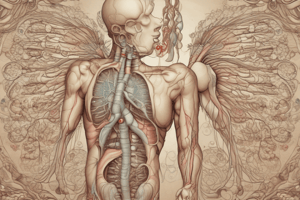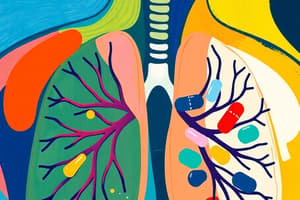Podcast
Questions and Answers
What is the role of anticholinergics in managing respiratory conditions?
What is the role of anticholinergics in managing respiratory conditions?
- They enhance mucus production.
- They reduce bronchoconstriction and decrease mucus production. (correct)
- They increase the rate of shallow breathing.
- They block sympathetic activity.
What indicates excessive sympathetic activity during the weaning process from mechanical ventilation?
What indicates excessive sympathetic activity during the weaning process from mechanical ventilation?
- Cyanosis in the patient.
- Decreased respiratory rate.
- Rapid, shallow breathing. (correct)
- Enhanced parasympathetic tone.
Which medication may be used to support optimal respiratory patterns in mechanically ventilated patients?
Which medication may be used to support optimal respiratory patterns in mechanically ventilated patients?
- Bronchodilators only.
- Antihistamines.
- Sedatives and paralytics. (correct)
- Antibiotics.
Which breathing techniques help promote parasympathetic activity for patients with chronic respiratory diseases?
Which breathing techniques help promote parasympathetic activity for patients with chronic respiratory diseases?
What should respiratory therapists monitor for during sympathetic activation in emergencies?
What should respiratory therapists monitor for during sympathetic activation in emergencies?
Which of the following is NOT a primary function of the sympathetic nervous system related to respiration?
Which of the following is NOT a primary function of the sympathetic nervous system related to respiration?
What is the primary difference between the sympathetic and parasympathetic nervous systems in the context of respiration?
What is the primary difference between the sympathetic and parasympathetic nervous systems in the context of respiration?
Which of the following would most likely be observed in a patient experiencing a fight-or-flight response?
Which of the following would most likely be observed in a patient experiencing a fight-or-flight response?
A respiratory therapist is treating a patient with asthma. Which of the following medications is most likely to be used to induce bronchodilation?
A respiratory therapist is treating a patient with asthma. Which of the following medications is most likely to be used to induce bronchodilation?
What is the primary role of the parasympathetic nervous system in respiration?
What is the primary role of the parasympathetic nervous system in respiration?
Which of the following is a key difference between the sympathetic and parasympathetic effects on airway smooth muscle?
Which of the following is a key difference between the sympathetic and parasympathetic effects on airway smooth muscle?
How does the sympathetic nervous system regulate breathing during exercise?
How does the sympathetic nervous system regulate breathing during exercise?
Which of the following is an accurate description of the role of mucus production in the respiratory system?
Which of the following is an accurate description of the role of mucus production in the respiratory system?
Flashcards
Autonomic Nervous System
Autonomic Nervous System
A system controlling involuntary bodily functions divided into SNS and PNS.
Sympathetic Nervous System (SNS)
Sympathetic Nervous System (SNS)
Part of the autonomic nervous system that prepares the body for 'fight or flight'.
Parasympathetic Nervous System (PNS)
Parasympathetic Nervous System (PNS)
Part of the autonomic nervous system that promotes 'rest and digest'.
Bronchodilation
Bronchodilation
Signup and view all the flashcards
Increased Respiratory Rate
Increased Respiratory Rate
Signup and view all the flashcards
Bronchoconstriction
Bronchoconstriction
Signup and view all the flashcards
Decreased Respiratory Rate
Decreased Respiratory Rate
Signup and view all the flashcards
Clinical Implications for RTs
Clinical Implications for RTs
Signup and view all the flashcards
Anticholinergics
Anticholinergics
Signup and view all the flashcards
Sympathetic Activation
Sympathetic Activation
Signup and view all the flashcards
Sedation and Paralysis
Sedation and Paralysis
Signup and view all the flashcards
Weaning from Mechanical Ventilation
Weaning from Mechanical Ventilation
Signup and view all the flashcards
Breathing Exercises
Breathing Exercises
Signup and view all the flashcards
Study Notes
Autonomic Nervous System Overview
- The autonomic nervous system is divided into two branches: the sympathetic nervous system (SNS) and the parasympathetic nervous system (PNS).
- These systems work in opposition to maintain homeostasis and respond to bodily needs.
Sympathetic Nervous System (SNS)
- Often called the "fight or flight" system.
- Prepares the body for stress or emergencies.
- Key functions in respiratory therapy include:
- Bronchodilation: Relaxes smooth muscles in bronchioles, widening airways (bronchodilation) and increasing airflow.
- Increased Respiratory Rate: Increases rate to deliver more oxygen to muscles and vital organs.
- Reduced Mucus Production: Decreases mucus secretion, helping keep airways clear.
Parasympathetic Nervous System (PNS)
- Often called the "rest and digest" system.
- Promotes relaxation and conservation of energy.
- Key functions in respiratory therapy include:
- Bronchoconstriction: Contracts smooth muscles in bronchioles, narrowing the airways (bronchoconstriction).
- Decreased Respiratory Rate: Lowers rate for a slower, more relaxed breathing pattern.
- Increased Mucus Production: Increases mucus secretion to trap and remove particles/pathogens.
Clinical Implications for Respiratory Therapists
- Respiratory therapists (RTs) need to understand these mechanisms for effective patient management.
Asthma and COPD Management
- Bronchodilators: Mimic sympathetic activity to open airways.
- Anticholinergics: Block parasympathetic activity reducing bronchoconstriction.
Acute Respiratory Distress
- Sympathetic Activation: Can cause rapid, shallow breathing in emergencies. RTs may use medications or mechanical ventilation to manage.
Ventilator Management
- Sedation and Paralysis: Used to modulate the ANS to achieve optimal respiratory patterns in mechanically ventilated patients.
Weaning from Mechanical Ventilation
- Stress Response: Understanding autonomic response during weaning is essential. Excessive sympathetic activity indicates distress.
Pulmonary Rehabilitation
- Breathing Exercises: Techniques promoting parasympathetic activity (e.g., diaphragmatic breathing) can improve respiratory function and reduce anxiety.
Studying That Suits You
Use AI to generate personalized quizzes and flashcards to suit your learning preferences.




